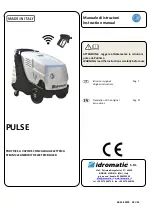
ROBOVENT • SPIRE SERIES OWNER’S MANUAL
11
SECTION 200
Glossary of Terms
work" such as welding on stainless steel and other alloy steels containing chromium
metal. Cr(VI) compounds may be used as pigments in dyes, paints, inks, and plastics.
It also may be used as an anticorrosive agent added to paints, primers, and other
surface coatings. The Cr(VI) compound chromic acid is used to electroplate chromium
onto metal parts to provide a decorative or protective coating.
HMI:
A human-machine interface (HMI) is the user interface that connects an operator to
the controller for an industrial system. In the dust collection industry, these interfaces
are utilized to connect the operator with the PLC that is controlling the operation of
the equipment.
Hopper:
A container for a bulk material such as grain, rock, or trash, typically one that
tapers downward and is able to discharge its contents at the bottom. In the dust
collection industry, a hopper is used to contain and funnel collected particulate into a
tray or barrel so it can be cleaned out and/or removed from the dust collector.
OSHA:
The Occupational Safety and Health Administration, an agency of the US
government under the Department of Labor with the responsibility of ensuring safety
at work and a healthful work environment. OSHA's mission is to prevent work-related
injuries, illnesses and deaths.
Plenum:
an enclosed chamber where a treated substance collects for distribution, as
heated or conditioned air through a ventilation system.
Pulse Cleaning System:
In RoboVent’s Spire Dust Collectors, dust and fume enters from
the side or back of the unit and flows from outside to inside the cartridge filters.
The cartridge filters are cleaned by short bursts of compressed air injected through
a common manifold that supports individual solenoid valves. The compressed air
is accelerated by a special nozzle mounted above the filter cartridge. Since the
duration of the compressed-air burst is very short, it acts as a rapidly moving air
bubble, traveling through the entire length of the cartridge and causing the surfaces
to flex. This flexing of the cartridges breaks the dust cake, and the dislodged dust
falls into a storage tray or hopper below. Reverse pulse-jet dust collectors can be
operated continuously and cleaned without interruption of flow because the burst of
compressed air is very small compared with the total volume of dusty air through the
collector. The bursts of air are timed, and controlled by the pressure differential of the
filters, as well as by pre-programmed threshold settings within the collectors onboard
control system.
Summary of Contents for Spire MLS-01-5500-10
Page 2: ......
Page 6: ......
Page 7: ...ROBOVENT SPIRE SERIES OWNER S MANUAL 7 SECTION 100 Important Safety Instructions ...
Page 9: ...SECTION 200 Glossary of Terms ...
Page 13: ...SECTION 300 Features of the Spire Series Collector ...
Page 18: ...18 ROBOVENT SPIRE SERIES OWNER S MANUAL ...
Page 19: ...SECTION 400 Receiving Inspection ...
Page 21: ...SECTION 500 Installation ...
Page 26: ...26 ROBOVENT SPIRE SERIES OWNER S MANUAL ...
Page 27: ...SECTION 600 Start up Commissioning ...
Page 31: ...SECTION 700 System Balancing ...
Page 39: ...SECTION 900 Maintenance ...
Page 52: ...52 ROBOVENT SPIRE SERIES OWNER S MANUAL ...
Page 53: ...ROBOVENT SPIRE SERIES OWNER S MANUAL 53 SECTION 1000 Troubleshooting ...
Page 58: ...58 ROBOVENT SPIRE SERIES OWNER S MANUAL ...
Page 59: ...APPENDIX A General Wiring Diagrams ...
Page 65: ...APPENDIX B Parts List ...
Page 66: ...B 2 ROBOVENT SPIRE SERIES OWNER S MANUAL APPENDIX B Parts List C D E F G M L K J I H A B ...












































